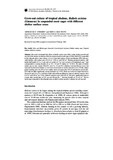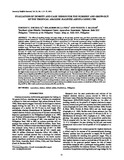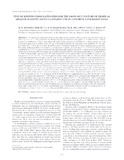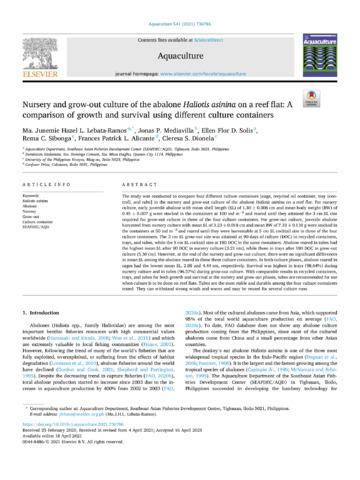Grow-out culture of tropical abalone, Haliotis asinina (Linnaeus) in suspended mesh cages with different shelter surface areas

View/
Request this document
Date
2001Page views
445Metadata
Show full item recordCited times in Scopus
Share
Abstract
This study investigated the effects of shelter surface area (SSA) on the feeding, growth and survival of the donkey-ear abalone, Haliotis asinina reared in mesh cages (0.38×0.38×0.28m) suspended in flow-through tanks (water volume = 6 m3). Cages had sections of polyvinylchloride (PVC) that provided shelters with surface area of 0.22 m2, 0.44 m2 and 0.66 m2. Hatchery-produced abalone with initial shell length of 32 ± 1 mm and wet weight of 7.5 g were stocked at 50 individuals cage−1 that corresponded to stocking densities of ca. 227, 113 and 75 abalone m−2 of SSA. The ratios of shelter surface area to cage volume (SSA:CV) were 5.5, 11 and 16.5. Abalones were provided an excess red seaweed Gracilariopsis bailinae (= Gracilaria heteroclada) at weekly intervals over a 270-day culture period. Feeding rates (18–20% of wet weight), food conversion ratio (26–27) and percent survival (88–92%) did not differ significantly among treatments (p > 0.05). Body size at harvest ranged from 56 to 59 mm SL and 52 to 57 g wet body weight with significant differences between abalone reared at SSA 0.22 m2 and 0.66 m2 (p < 0.05). Abalone reared in cages with 0.66 m2 SSA grew significantly faster at average daily growth rates of 132 μm and 188 mg day−1. Stocking densities of 75–113m−2 SSA in mesh cages suspended in flow-through tanks resulted in better growth of abalone fed red seaweed.
Keywords
Grow-out Mesh cages Seaweed (Gracilariopsis bailinae) Shelter surface area Tropical abalone (Haliotis asinina)Suggested Citation
Fermin, A. C., & Buen, S. M. (2001). Grow-out culture of tropical abalone, Haliotis asinina (Linnaeus) in suspended mesh cages with different shelter surface areas. Aquaculture International , 9(6), 499-508. https://doi.org/10.1023/A:1020535301193
Subject
Taxonomic term
Collections
- AQD Journal Articles [1240]
Related items
Showing items related by title, author, creator and subject.
-
Evaluation of density and cage design for the nursery and grow-out of the tropical abalone Haliotis asinina Linne 1758
Encena II, Vincent C.; de la Peña, Milagros; Balinas, Vicente T. (National Shellfisheries Association, 2013)The effect of stocking density and cage design on the growth, survival rate, and feed conversion ratio was evaluated for the nursery (11–15 mm in shell length) and juvenile grow-out (26–30 mm in shell length) of the tropical ... -
Test of refined formulated feed for the grow-out culture of tropical abalone Haliotis asinina (Linnaeus 1758) in concrete land-based tanks
Bautista-Teruel, Myrna N.; Maquirang, Jean Rose H.; de la Peña, Milagros R.; Balinas, Vicente T. (National Shellfisheries Association, 2016)A refined formulated feed for the grow-out culture of tropical abalone Haliotis asinina was evaluated to assess its suitability for a shorter culture period (<8 mo). Refinement procedures focused on the application of ... -
Nursery and grow-out culture of the abalone Haliotis asinina on a reef flat: A comparison of growth and survival using different culture containers
Lebata-Ramos, Ma. Junemie Hazel; Mediavilla, Jonas P.; Solis, Ellen Flor; Sibonga, Rema; Alicante, Frances Patrick L.; Dionela, Cleresa S. (Elsevier, 2021-08)The study was conducted to compare four different culture containers [cage, recycled oil container, tray (control), and tube] in the nursery and grow-out culture of the abalone Haliotis asinina on a reef flat. For nursery ...





